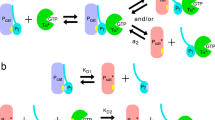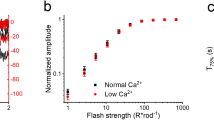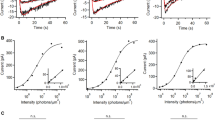Abstract
Light-induced activation of cyclic GMP phosphodiesterase (PDE) in the outer segments of vertebrate rod photoreceptors has been suggested as a step in the transduction process linking the absorption of light by rhodopsin with a hyperpolarization of the plasma membrane1–3. Activation of PDE is mediated by a ‘GTP-binding protein’ (G). As a result of interaction with a rhodopsin photoproduct (possibly metarhodopsin II380), this GTP-binding protein exchanges a previously bound GDP for a GTP4,5. This ‘GTP-charged’ protein (GGTP) is thought to activate PDE through an interaction in which an inhibitory protein is released from PDE6–8. Assays of PDE activity in vitro have demonstrated that the hydrolysis of cyclic GMP occurs within milliseconds of light onset9, which suggests that this process is rapid enough to be an intermediate step in transduction. To test this idea electrophysiologically, we have injected purified GTP-binding protein that was binding a hydrolysis-resistant analogue of GTP, guanylyl imidodiphosphate (p(NH)ppG), termed Gp(NH)ppG, as well as partially purified PDE, into toad rod outer segments while recording membrane voltage. We report here that injection of either of these biochemically active proteins induces a reversible hyperpolarization of the rod membrane, while injection of inactive proteins seems to have no effect on membrane voltage.
This is a preview of subscription content, access via your institution
Access options
Subscribe to this journal
Receive 51 print issues and online access
$199.00 per year
only $3.90 per issue
Buy this article
- Purchase on Springer Link
- Instant access to full article PDF
Prices may be subject to local taxes which are calculated during checkout
Similar content being viewed by others
References
Bitensky, M. W., Gorman, R. E. & Miller, W. H. Proc. natn. Acad. Sci. U.S.A. 68, 561–562 (1971).
Nicol, G. D. & Miller, W. H. Proc. natn. Acad. Sci. U.S.A. 75, 5217–5220 (1978).
Liebman, P. A. & Pugh, E. N. Jr. Vision Res. 19, 375–380 (1979).
Kuhn, H., Bennett, N., Michel-Villaz, M. & Chabre, M. Proc. natn. Acad. Sci. U.S.A. 78, 6873–6877 (1981).
Fung, B. K.-K. & Stryer, L. Proc. natn. Acad. Sci. U.S.A. 77, 2500–2504 (1980).
Hurley, J. B. Biochem. biophys. Res. Commun. 92, 505–510 (1980).
Hurley, J. B. & Stryer, L. J. biol. Chem. 253, 1802–1809 (1982).
Yamazaki, A., Uchida, S., Stein, P. J., Wheeler, G. L. & Bitensky, M. Adv. Cyclic Nucleotide Res. (in the press).
Yee, R. & Liebman, P. A. J. biol. Chem. 253, 8902–8909 (1978).
Brown, J. E. & Pinto, L. H. J. Physiol., Lond. 236, 575–591 (1974).
Brown, J. E., Coles, J. A. & Pinto, L. H. J. Physiol., Lond. 269, 707–722 (1977).
Oakley, B., II & Pinto, L. H. Curr. Topics Membranes Transp. 15, 405–416 (1981).
Oakley, B., II & Pinto, L. H. J. Physiol., Lond. 339, 273–298 (1983).
Kuhn, H. Nature 283, 587–589 (1980).
Kuhn, H. Curr. Topics Membranes Transp. 15, 171–201 (1981).
Baer, W., Devlin, M. J. & Applebury, M. L. J. biol. Chem. 254, 11669–11677 (1979).
Yamazaki, A., Stein, P., Chernoff, N. & Bitensky, M. J. biol. Chem. 258, 8188–8194 (1983).
Yamazaki, A., Sen, I., Bitensky, M. W., Casnelli, J. E. & Greengard, P. J. biol. Chem. 255, 11619–11624 (1980).
Wheeler, G. L. & Bitensky, M. L. Proc. natn. Acad. Sci. U.S.A. 74, 4238–4242 (1977).
Mueller, P. & Pugh, E. N. Jr. Proc. natn. Acad. Sci. U.S.A. 80, 1892–1896 (1983).
Baylor, D. A., Hodgkin, A. L. & Lamb, T. D. J. Physiol., Lond. 242, 759–791 (1974).
Fleischman, D. & Denisevich, M. Biochemistry 18, 5060–5066 (1979).
Baylor, D. A. Invest. Ophthal. vis. Sci. 24, ARVO Suppl., 16 (1983).
Author information
Authors and Affiliations
Rights and permissions
About this article
Cite this article
Clack, J., Oakley, B. & Stein, P. Injection of GTP-binding protein or cyclic GMP phosphodiesterase hyperpolarizes retinal rods. Nature 305, 50–52 (1983). https://doi.org/10.1038/305050a0
Received:
Accepted:
Issue Date:
DOI: https://doi.org/10.1038/305050a0
This article is cited by
-
Mechanism for the regulation of mammalian cGMP phosphodiesterase6. 1: Identification of its inhibitory subunit complexes and their roles
Molecular and Cellular Biochemistry (2010)
Comments
By submitting a comment you agree to abide by our Terms and Community Guidelines. If you find something abusive or that does not comply with our terms or guidelines please flag it as inappropriate.



